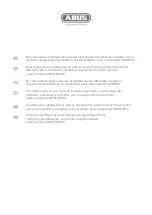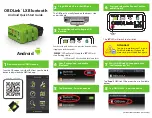
.00 20100521
(
)
9
3.
OPERATING INSTRUCTIONS
3.1
General
Typically, the XenoWorks™ Analog Microinjector is used to vary slightly the pressure in the
tip of a glass micropipette, thus depositing or aspirating cells or cellular components. The
XenoWorks analog microinjector has been designed to work with a number of different
syringe volumes, with different tubing lengths and with different hydraulic fluids or simply
with air. In this way, the performance of the device can be precisely tuned to the application
for which it is used.
The microinjector can employ air, mineral oils or water as the hydraulic fluid, and syringe
volumes from 100 to 1000 microliters can be used. A 500 microliter syringe is supplied
standard with the device, but 100 and 1000 microliter models are available from Sutter
Instrument.
100 microliter – part number V001183
500 microliter – part number V001185
1000 microliter – part number V001186
The XenoWorks Analog Microinjector has two controls: coarse and fine. The coarse control
provides ten times the fluid displacement of the fine control. Turn the controls clockwise to
inject and counter-clockwise to aspirate.
3.2
Fitting a Micropipette
NOTE: If using air instead of a fluid in the microinjector, skip Step 1.
1.
First, remove the clear chuck from the front of the micropipette, and turn the injector’s
coarse control clockwise to advance the hydraulic fluid to the end of the black aluminum
pressure fitting.
2.
Replace the clear chuck, but do not tighten it yet.
3.
Gently ease a micropipette whose maximum outer diameter does not exceed 1mm into the
chuck. The three black O-rings inside the chuck will create a little resistance, which can
be overcome by gently turning the micropipette holder body while simultaneously
pushing the micropipette in. Do not use excessive force. If the micropipette will not fit
snugly in the holder, the O-rings are either damaged or are obstructing the holder and
should be replaced.
4.
The micropipette should be pushed into the chuck until the hard backstop is felt. At this
point, stop pushing and withdraw the micropipette 1 to 2 mm.
5.
Gently tighten the chuck so that the O-rings are compressed, and form a seal around the
outer diameter of the micropipette.
CAUTION: Do not over-tighten the chuck, or damage
may occur to the O-rings.
6.
Turn the coarse control clockwise until the air-fluid meniscus is at the desired point in
the micropipette.
7.
The newly fitted micropipette and holder can now be attached to the micromanipulator in
readiness for microinjection.
XENOWORKS ANALOG MICROINJECTOR OPERATION MANUAL – REV. 4
Summary of Contents for XenoWorks BRI
Page 3: ......
Page 4: ......
Page 28: ...00 20100521 20 NOTES XENOWORKS ANALOG MICROINJECTOR OPERATION MANUAL REV 4...












































